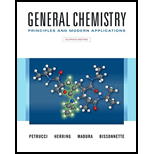
Concept explainers
(a)
Interpretation:
The name and the formula complex ion consist of Cr3+ as the central ion and two NH3 molecules and four Cl- ions as ligands should be determined.
Concept introduction:
The coordination number of any complex is established by the total number of ions or atoms proximately surrounding or nearest to the central atom in a crystal or compound.
The oxidation number of an atom is equivalent to the charge on the ion, e.g. Na+ has the oxidation number of +1 and O2- has -2. In a molecule or compound, it is the sum of the oxidation numbers of its component atoms. The total charge of the ligands is deducted from the overall charge of the coordinate complex.
When any complex is named, the ligands are named foremost, in the alphabetical order, and the metal atom or ion is named afterward. Conversely, in the chemical formula, the metal atom or ion is marked before the ligands.
Answer to Problem 1E
The formula of the complex is
Explanation of Solution
The complex has Cr3+ as the central ion and two NH3 molecules and four Cl- ions as ligands surrounding the central ion.NH3molecules are neutral, and four Cl-ions carry -1 charge each. The oxidation number of the central ion is +3. The net charge of the complex is -1
Therefore, the formula of the complex is
(b)
Interpretation:
The formula and name of a complex which consist of iron(III) with coordination number of 6 and CN- as ligands should be determined.
Concept introduction:
The coordination number of any complex is established by the total number of ions or atoms proximately surrounding or nearest to the central atom in a crystal or compound.
The oxidation number of an atom is equivalent to the charge on the ion, e.g. Na+ has the oxidation number of +1 and O2- has -2. In a molecule or compound, it is the sum of the oxidation numbers of its component atoms. The total charge of the ligands is deducted from the overall charge of the coordinate complex.
When any complex is named, the ligands are named foremost, in the alphabetical order, and the metal atom or ion is named afterward. Conversely, in the chemical formula, the metal atom or ion is marked before the ligands.
Answer to Problem 1E
The formula of the complex is
Explanation of Solution
The complex has Iron as the central ion and six CN- ions as ligands surrounding the central ion.
Therefore, the formula of the complex is
(c)
Interpretation:
The name and the formula of a coordination compound consists of given complex ions: one a complex contain Cr(III) with ethylenediamine (en) having coordination number 6 and second, a complex contain Ni(II) with CN- having coordination number should be determined.
Concept introduction:
The coordination number of any complex is established by the total number of ions or atoms proximately surrounding or nearest to the central atom in a crystal or compound.
The oxidation number of an atom is equivalent to the charge on the ion, e.g. Na+ has the oxidation number of +1 and O2- has -2. In a molecule or compound, it is the sum of the oxidation numbers of its component atoms. The total charge of the ligands is deducted from the overall charge of the coordinate complex.
When any complex is named, the ligands are named foremost, in the alphabetical order, and the metal atom or ion is named afterward. Conversely, in the chemical formula, the metal atom or ion is marked before the ligands.
Answer to Problem 1E
The formula of the complex is
Explanation of Solution
In the first complex, ethylenediamine is a neutral ligand. Thus, for a complex of Cr (III) containing three en the charge from ligands will be0. Combined with a +3-oxidation state metal, this complex will have a charge of +3 and will, therefore, be the cationic part of the double complex is [Cr(en)3]+3.
In the Ni (II) complex, as mentioned above, each CN will contribute a charge of -1 giving the tetracyano complex a charge of -4 from the ligands. This, with the +2 oxidation on nickel gives the complex a net negative charge -2 making it the anionic part of the double compound with the formula [NiCN4]2-.
Therefore, the formula of the complex is
Want to see more full solutions like this?
Chapter 24 Solutions
Mastering Chemistry With Pearson Etext -- Standalone Access Card -- For General Chemistry: Principles And Modern Applications (11th Edition)
- What types of isomers are possible for the following compounds or complex ions? (a) K[Co(NH3)2Cl4] (b) Pt(en)Cl2 (square-planar) (c) [Co(NH3)5Cl]2+ (d) [Ru(phen)3]Cl3 (e) Na2[MnCl4] (tetrahedral) (f) [Co(NH3)5NO2)2+arrow_forwardExperiments show that K4[Cr(CN)6] is paramagnetic and has two unpaired electrons. The related complex K4[Cr(SCN)6] is paramagnetic and has four unpaired electrons. Account for the magnetism of each compound using the ligand field model. Predict where the SCN ion occurs in the spectro-chemical series relative to CN.arrow_forwardWhich of the following statement(s) is( are) true? a. The coordination number of a metal ion in an octahedral complex ion is 8. b. All tetrahedral complex ions are low-spin. c. The formula for triaquatrianuninechromiwn(III) sulfate is [Cr(H2O)3(NH3)](SO4)3. d. The electron configuration of Hf2+ is [Xe]4f126s2. e. Hemoglobin contains Fe3+.arrow_forward
 Chemistry: An Atoms First ApproachChemistryISBN:9781305079243Author:Steven S. Zumdahl, Susan A. ZumdahlPublisher:Cengage Learning
Chemistry: An Atoms First ApproachChemistryISBN:9781305079243Author:Steven S. Zumdahl, Susan A. ZumdahlPublisher:Cengage Learning
 ChemistryChemistryISBN:9781305957404Author:Steven S. Zumdahl, Susan A. Zumdahl, Donald J. DeCostePublisher:Cengage Learning
ChemistryChemistryISBN:9781305957404Author:Steven S. Zumdahl, Susan A. Zumdahl, Donald J. DeCostePublisher:Cengage Learning Chemistry & Chemical ReactivityChemistryISBN:9781337399074Author:John C. Kotz, Paul M. Treichel, John Townsend, David TreichelPublisher:Cengage Learning
Chemistry & Chemical ReactivityChemistryISBN:9781337399074Author:John C. Kotz, Paul M. Treichel, John Townsend, David TreichelPublisher:Cengage Learning Chemistry & Chemical ReactivityChemistryISBN:9781133949640Author:John C. Kotz, Paul M. Treichel, John Townsend, David TreichelPublisher:Cengage Learning
Chemistry & Chemical ReactivityChemistryISBN:9781133949640Author:John C. Kotz, Paul M. Treichel, John Townsend, David TreichelPublisher:Cengage Learning Chemistry: The Molecular ScienceChemistryISBN:9781285199047Author:John W. Moore, Conrad L. StanitskiPublisher:Cengage Learning
Chemistry: The Molecular ScienceChemistryISBN:9781285199047Author:John W. Moore, Conrad L. StanitskiPublisher:Cengage Learning





